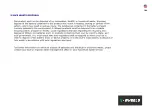
5
Winter storage
5
.1
When storing
1.
Clean the product with a slightly damp cloth. Remove dirt that may have settled on the product. Feel free to use wet wipes, a
tooth brush or Q-tips to reach difficult spots.
2.
It is extremely important to use salt removers or similar products if the scooter has been used on salted roads and
pavements. This to prevent corrosion. NB! Damages caused by salt is not covered by warranty.
3.
Spray WD40 on moving parts and bolts (do not use on plastic).
4.
The battery should be charged to 60-80%. NB! Charge to maximum 80%, lithium batteries must not be stored fully charged,
nor with low battery percentage.
5.
Fill the tires to their recommended air pressure (3.4 – 4 bar, or 50-60psi).
6.
Store your electric scooter in a dry place, the temperature should be between 5-20°C
7.
I
t is crucial to charge the scooter at least once a month, to around 60-80%.
If not, the battery will take damage.
Lithium
batteries follows a process that constantly needs to run in order for them to stay alive. This process “feeds” of the
power, and
the battery percentage therefore decreases by time. When the battery percentage is too low, the battery will
eventually feed
from its own battery cells to stay alive.
This is what damages the battery and what causes reduced performance and eventually a defective battery. This applies to all
lithium batteries and you should always follow this procedure for all your products with these kinds of batteries. Phones and
laptops are examples of products using lithium batteries. The rate at which the battery percentage decreases depends on the
temperature of the storage location, avoid therefore storage in cold places.
EN
5
.
2
After storage
1.
Make sure the folding lever is tight when the steering column i
s
in a
n
upright position. Make sure there is no slack or play in
the folding mechanism. Tighten the folding mechanism if needed.
2.
How to avoid slack in the steering column?
It is extremely important to maintain a good and active weight balance on the
standing board. Keep one foot in front and one foot on the back of the board. When accelerating, distribute the weight more to
the front foot. When braking, distribute the weight more to the rear foot. This is to avoid wear on the handlebar. As a result of
the Principle of Leverage, the force loaded at the bottom of the steering column will be enormously when fully accelerating or
braking if you pull and lean on the steering/handlebars. This is avoided with active weight balance.
3.
Make sure to regularly check and tighten all screws when needed. For frequent use, please check once every 1-2 weeks. This
also depends on the type of surface you’re riding on, for example will use on cobblestones lead to more frequent need for
tightening.
4.
Charge the scooter to 100% before your first ride, and leave it
charging
for an extra hour after the battery is fully charged.
5.
F
ill the tires to their recommended air pressure (3.4 – 4 bar, or 50-60psi).
6.
Always check the brake
s
before using the product. If it does not brake sufficiently, then the issue
must be resolved before using the product.





































